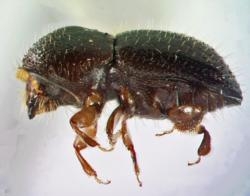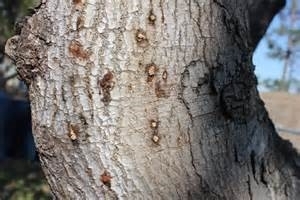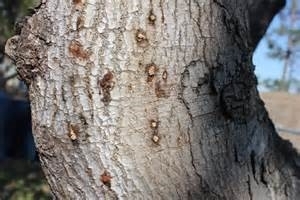- Author: Ben Faber
There's a lot of work being done in Florida on a pest/disease complex like we have here with Shot Hole Borer and Fusarium fungus – Fusarium Dieback. This hits avocados and a lot of other native trees like sycamore, willow and coast live oak. Some of the success in Florida may be applicable and we are working with their researchers there to adapt some of the techniques here.
Redbay ambrosia beetle, Xyleborus glabratus, is a wood-boring pest that has now invaded nine states in the southeastern United States. The beetle's dominant fungal symbiont (Raffaelea lauricola) is phytopathogenic, inducing laurel wilt in trees within the family Lauraceae. Members of the genus Persea are particularly susceptible to the lethal disease, including native redbay (P. borbonia) and swampbay (P. palustris), as well as commercial avocado. Cubeb oil lures are the current standard for detection of X. glabratus, but recently eucalyptol and a 50% α-copaene oil have been identified as additional attractants. This study used a combination of choice bioassays, field cage release-and-recapture assays, and a 12-week field trial to compare efficacy of eucalyptol and copaene lures relative to commercial cubeb lures. In addition, gas chromatography (analyzer for volatiles) was used to quantify emissions from lures field-aged for 12 wk. In field cage assays, copaene lures recaptured a higher percentage of released beetles than cubeb lures. In the field test, cubeb lures captured fewer beetles than copaene lures, and lowest captures were obtained with eucalyptol lures. Both copaene and cubeb lures were effective in attracting X. glabratus for 12 weeks, but field life of eucalyptol lures was only 4 weeks, consistent with the quantification of lure emissions. Results suggest that the 50% α-copaene lure provides the best pest detection currently available for X. glabratus.
So why is this important? For one, it will serve as a tool for more effectively monitoring the presents of the beetle. But more importantly, it might be used as a lure to attract them away from trees. Fool them into going somewhere else, like to die.

- Author: Richard Stouthamer
The recent find of the Kuroshio shot-hole borer in Santa Barbara shows that the beetle is expanding up the coast and it comes on top of the finding earlier this year of a single Kuroshio shot-hole borer in San Luis Obispo. Earlier yet in 2014 a single beetle identified as Euwallacea fornicatus was found by the CDFA monitoring in Santa Cruz county, unfortunately this specimen was only identified using morphological characters and therefore we do not know which of the three cryptic species of the Euwallacea fornicatus species complex we are dealing with for that particular find. After the single find (2016) in San Luis Obispo a several additional traps were placed in the vicinity of the first find but no additional beetles have been caught. In a single location in Irvine KSHB has also been detected last year (2015). Recently, the Kuroshio Shot-hole borer has also been reported in Tijuana Mexico, which is not surprising since the heavily infested Tijuana river valley park in San Diego county is less than 0.6 miles from the border with Tijuana. It is clear from these detections that the KSHB is on the move, just like the PSHB. These long distance moves by the beetles are most likely caused by human transport, and the most likely culprit is wood transported after trees have been cut down or trimmed. Both in San Luis Obispo and the location in Santa Cruz no additional finds have been reported, often the density of insects following an invasion of a new area remains low while the population is expanding and followed by it reaching such levels that they are “suddenly” detected in many locations.

- Author: Ben Faber
I used to think that you could not add enough mulch into an orchard and cause any harm. Well, I've been proved wrong a number of times. Some people have gone overboard and put on three to five feet for some reason and it causes all manner of problems, the least of which is usually just getting around in the orchard. But organic matter is the energy source that drives a lot of positive good in an orchard. It provides nutrients for the plants, as well as the microbes that protect plant health, keeps weeds down and maintains an even soil moisture content.
In agriculture, mulch has been viewed as an important input to maintain good tree health, especially in avocado orchards. That has been true up until the introduction of Asian Citrus Psyllid (ACP) and Polyphagous Shot Hole Borer (PSHB, and a close relative Kuroshio Shot Hole Borer ((KSHB))) into California. These are insects that carry disease that are lethal to trees. The ACP can carry a bacteria that causes the death of citrus trees. It has been a major cause of tree death in Florida, as well as other parts of the world. It is severely threatening the industry in that State as it does in California. It also threatens all backyard citrus wherever they are found. PSHB, on the other hand, is another insect that carries a fungal disease that threatens not just one species of tree, such as avocado, but many native trees, such as coast live oak, sycamore, willow and many other native tree species.
Initially these pests were pretty much confined to the Los Angeles Basin and south, but ACP has moved into the Central Valley, and through Ventura up the coast. Its progress has been monitored by traps. PSHB has been found in parts of Ventura County, but it is not widespread, as far as we know at this point. Both insects can be easily moved by contaminated plant material. ACP can be found in infested leaves and on fruit. Moving that material increases the likelihood of spread. PSHB can be moved in wood where it makes its galleries. Moving wood and chips, can spread this pest/disease complex.
The way to help control the spread of these two pest and their disease causing organisms is to stop the spread of materials. This means don't move material from known infested areas, such as the LA Basin into Ventura. It means know where your mulch is sourced. Ideally, if you mulch, it should be with material found onsite. Chip the trees on your property and use it there. This is a threat not only to you, but your neighbors, as well. Be a good neighbor.
For more on ACP and PSHB/KSHB see:
http://eskalenlab.ucr.edu/avocado.html
http://eskalenlab.ucr.edu/distribution.html
http://eskalenlab.ucr.edu/handouts.html
http://ucanr.edu/sites/KACCitrusEntomology/Training_Materials/Educational_Materials/
Photos: ACP and PSHB


- Author: Ben Faber
Without a doubt the borers, PSHB and KSHB are going to hurt avocado production, but there are some California native and landscape trees that are also going to get hammered, like unto death. Much has been written about the borers in the press, from ag journals to environmental newsletters to newspapers, such as the New York Times, Los Angeles Times and more local papers like the Ventura Star and Riverside Press-Enterprise. Recent trap findings of PSHB in Ventura county brought a local gathering of community groups to discuss the situation and the need to get more information out to local residents of the major environmental disaster at our doorstep, It seems most homeowners are not aware of the problem or if so marginally so. Is it because it's viewed as just an avocado growers' problem? The CA Avocado Commission has lead in research and spending on this problem that will affect all citizens, not just growers and consumers of the fruit. Are we all just overwhelmed by the disasters that are occurring around us here and world-wide?
I'm not sure why the lack of general interest in this issue, but the only way to get control of these pests is to stop their movement, which is largely through humans moving contaminated wood. Slowing the spread will give time to develop control methods and measures that will allow our native woodlands to cope with this infestation. There are currently people looking for pathogens and parasites in the native range of these pests, in order to determine if those native control measure would fit into a California system. But this is going to take time and in the meantime the spread needs to be slowed. Talk to your neighbors, co-workers and friends. And have them talk to their neighbors, co-workers and friends. Get the word out about what we can all do to slow the spread.
Listed below are some of the common plants in which the borer can reproduce and spread its fungi that kill the tree. Many more trees have been identified to which the borer goes, but as yet it's not known whether the fungi spread in those trees.
Known Suitable Reproductive Host Trees of PSHB:
2. Big leaf maple (Acer macrophyllum)*
3. Evergreen Maple (Acer paxii)
4. Trident maple (Acer buergerianum)
5.Japanese maple (Acer palmatum)
6. Castor bean (Ricinus communis)
7. California Sycamore (Platanus racemosa)*
8. Mexican sycamore (Platanus mexicana)
9. Red Willow (Salix laevigata)*
10. Avocado (Persea americana)
11. Mimosa (Albizia julibrissin)
12. English Oak (Quercus robur)
13. Coast live oak (Quercus agrifolia)*
14. London plane (Platanus x acerifolia)
15.Cottonwood (Populus fremontii)*
16. Black cottonwood (Populus trichocarpa)*
17. White Alder (Alnus rhambifolia)*
18.Titoki (Alectryon excelsus)
19. Engelmann Oak (Quercus engelmannii)*
20. Cork Oak (Quercus suber)
21. Valley oak (Quercus lobata)*
22. Coral tree (Erythrina corallodendon)
23. Blue palo verde (Cercidium floridum)*
24. Palo verde (Parkinsonia aculeata)
25. Moreton Bay Chestnut (Castanospermum australe)
26. Brea (Cercidium sonorae)
27. Mesquite (Prosopis articulata)*
28. Weeping willow (Salix babylonica)
29. Chinese holly (Ilex cornuta)
30. Camelia (Camellia semiserrata)
31. Acacia (Acacia spp.)
32. Liquidambar (Liquidambar styraciflua)
33. Red Flowering Gum (Eucalyptus ficifolia)
34. Japanese wisteria (Wisteria floribunda)
35. Goodding's black willow (Salix gooddingii)*
36. Tree of heaven (Alianthus altissima)
37. Kurrajong (Brachychiton populneus)
38. Black mission fig (Ficus carica)
Known Suitable Reproductive Host Trees of KSHB
1. Avocado (Persea americana)
2. California Sycamore (Platanus racemosa)*
3. Coast live oak (Quercus agrifolia)*
4. Cork oak (Quercus suber)
5. Draft coral tree (Erythrina humeana)
- Black Polar (Populus nigra)
7. Black locust (Robinia pseudoacacia)
8. Red Willow (Salix laevigata)*
- Arroyo willow (Salix lasolepis)*
- Cottonwood (Populus fremontii)*
11. Mimosa (Albizia julibrizin)
12. Castor bean (Ricinus communis)
13. Black Willow (Salix nigra)*
14. Strawberry Snowball Tree (Dombeye cacuminum)
*Native species to California
For other information sources of what these new borers can do to our wildscapes check out:
http://ucanr.edu/sites/socaloakpests/

- Author: Ben Faber
A note from UC Riverside Plant Pathologist, Akif Eskalen
Hello,
We just confirmed that the riparian forest in the Tijuana river valley in San Diego is infested with Kuroshio Shot Hole Borer. Rod Dossey and his team from WRA, Environmental Consultants first noticed the sign and symptoms of the beetle on Sept 25th, and contacted us for the confirmation. I have visited the site last week and mortality is already occurring on many trees including Arroyo Willow, Black Willow and Castor Bean. Please let me know if you have any questions.
PSHB/KSHB distribution map
http://ucanr.maps.arcgis.com/apps/Viewer/index.html?appid=3446e311c5bd434eabae98937f085c80
Regards
Akif




